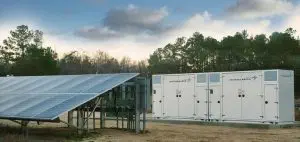 The accelerating transformation of the solar industry into the solar-plus-storage industry was clear at Solar Power International (SPI) 2018, making questions about the true value of aggregating the resources to serve customers and the grid more urgent.
The accelerating transformation of the solar industry into the solar-plus-storage industry was clear at Solar Power International (SPI) 2018, making questions about the true value of aggregating the resources to serve customers and the grid more urgent.
Much conference chatter surrounded getting technology, markets and policy for solar, storage and distributed energy resources (DERs) to work together. Developers that expect real market penetration to follow policy solutions brought some of the hottest questions regarding the advancement of DER.
“In high penetration markets, the bulk of solar sold is now being sold with storage, and solar-plus-storage will supplant standalone solar over time,” according to former Maryland public utilities commissioner Anne Hoskins, now Chief Policy Officer for leading distributed solar-plus-storage builder, Sunrun. “How fast it happens depends on the underlying compensation and rate design.”
Most storage today is at transmission system scale. But behind-the-meter storage and other DERs have grown rapidly and are forecast by industry leaders to play a bigger role.
It is “widely agreed” that battery energy storage offers 13 monetizable services, Ani Backa, Sonnen director of regulatory strategy and utility initiatives, told Utility Dive. She referred to the findings of a 2015 Rocky Mountain Institute (RMI) paper on battery energy storage economics regarding more than a dozen grid services featured in the graphic below.
“A formal process to study those 13 services could help identify and quantify use cases for the distribution system that have instant value to utilities,” Backa added. “Instead of seeing storage as a limitation, utilities might see it as part of a new business model built around revenue sharing with end users.”
Both the U.S. solar photovoltaic (PV) and storage industries are expanding. PV is bouncing back after being slowed by import-tariffs imposed in 2017, which are now stepping down and will terminate in 2021. The 8.5 GW of utility-scale solar procured in the first half of 2018 was the industry’s biggest first-half procurement, according to the newest Wood Mackenzie-Solar Energy Industries Association (SEIA) market report.
Residential PV was essentially flat, year-over-year, which was “an encouraging sign of market stabilization after a year in which the market contracted 15%,” the report added. Non-residential PV fell 8%, but corporate procurement of utility-scale solar continued to grow and now represents 12% of projects being developed.
Overall, the report forecasts 2018 will match 2017’s 10.9 GW and growth will “more than double over the next five years.” By 2023, annual installed capacity is expected to be over 14 GW.
Leave a Reply